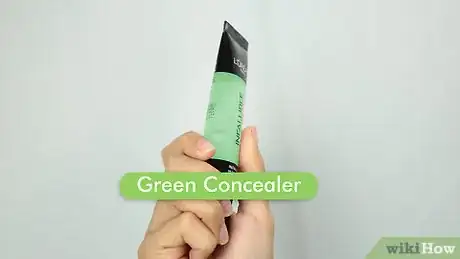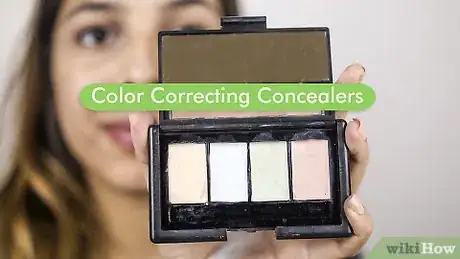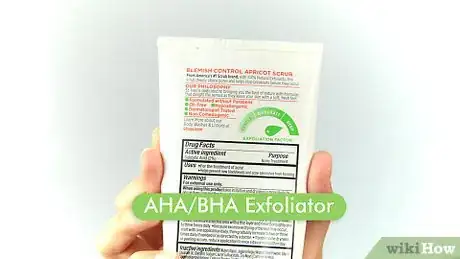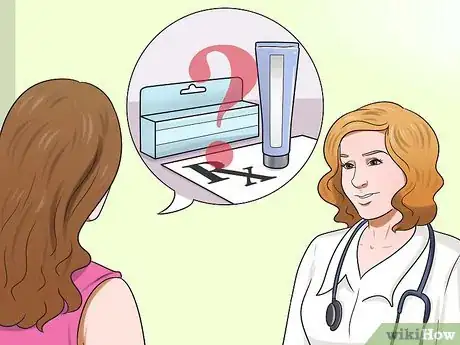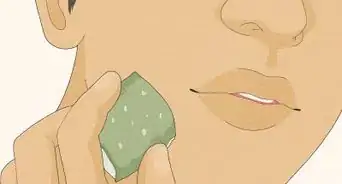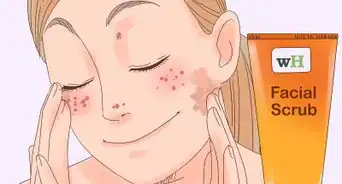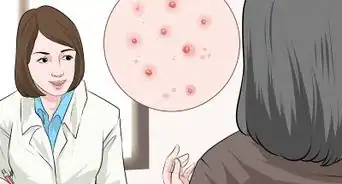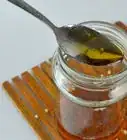This article was co-authored by Margareth Pierre-Louis, MD. Dr. Margareth Pierre-Louis is a board certified Dermatologist and Dermatopathologist, Physician Entrepreneur, and the Founder of Twin Cities Dermatology Center and Equation Skin Care in Minneapolis, Minnesota. Twin Cities Dermatology Center is a comprehensive dermatology clinic treating patients of all ages through clinical dermatology, cosmetic dermatology, and telemedicine. Equation Skin Care was created to provide the best in evidence-based, natural skin care products. Dr. Pierre-Louis earned a BS in Biology and an MBA from Duke University, an MD from the University of North Carolina at Chapel Hill, completed a residency in dermatology at the University of Minnesota, and completed a dermatopathology fellowship at Washington University in St Louis. Dr. Pierre-Louis is board certified in dermatology, cutaneous surgery, and dermatopathology by the American Boards of Dermatology and Pathology.
There are 9 references cited in this article, which can be found at the bottom of the page.
This article has been viewed 337,522 times.
Everyone has days when they look amazing but then there are those days when you end up finding a gross red spot on your face! Red spots may be difficult to cover up with a plain foundation, but when you use the correct concealer and follow the steps below, you can reduce or even completely conceal red spots.
Steps
Picking the Correct Concealer
-
1Choose a green-tinted concealer. When choosing a concealer, opt for those that are green-tinted; green is the opposite of red, which is why a green concealer offsets and neutralizes red spots.[1]
- Apply the concealer to the area you wish to neutralize and blend the edges for an even finish
- Make sure to work with thin layers of the product. It will be just as difficult to cover massive amounts of green as it is to cover the redness.
- Once you apply the product, go over with your regular foundation. Or apply the foundation first and then the concealer (see next section for full steps).[2]
-
2Buy concealers specifically designed for redness. These type of concealers cover up red spots resulting from acne breakouts or scars or even skin conditions, such as rosacea.
- Apply the concealer directly over red skin imperfections and blend together to create evenness.
Advertisement -
3Use a color corrector. Applying a color corrector under your foundation can mask red spots and other hyperpigmentation marks. This technique will lighten the dark area and improve an uneven skin tone.
- Lightly, dab the corrector to the discolored area.
-
4Use high-end concealers. Inexpensive products rarely help conceal large areas of red spots. These include concealers that are thin and runny and while they may hide small imperfections, they might not disguise darker spots. High-quality concealers, such as the Dermablend Cover Creme True Beige, are heavier and made to cover darker spots, acting both as a concealer and a foundation at the same time.
- Take a small amount of the product and heat it between your fingertips to soften.
- Apply directly over imperfection.
- Allow it to dry before applying additional layers if needed.
- Always set each layer of foundation with setting powder.
-
5Apply more intense coverage. Bigger acne lesions or spots require more concealing action. A concealer that is designed to deliver extra coverage will help mask various imperfections, such as blemishes, moles, and birthmarks.
Concealing Red Spots
-
1Wash your face. You want a clean fresh face before applying new makeup. Use warm water and face wash to remove dirt, oil, and other unwanted debris.
- Wet your face with warm water and lather your hands with the soap or face wash.
- Rub away dirt and rinse well.
- Always dry your skin well before applying any products.
-
2Use a mattifying daily moisturizer. Daily moisturizers with a matte finish help fight the appearance of breakouts by removing excess oil and calming the complexion.[3]
- Apply moisturizer to your face, making sure to cover every part.
- Let it dry before continuing to the next step.
-
3Apply foundation. Foundation is used to cover up uneven skin tones, red spots, or acne lesions. You may apply concealer before your foundation but adding foundation first allows you to really see where you need to use the concealer.[4]
- Prep your skin with a primer to smoothen everything so that the base glides on and doesn’t settle into lines, dry patches, or rough areas.
- Let primer dry before adding foundation.
- Apply a dime-sized amount of foundation to your hands and use your fingers to dot it on your forehead, nose, and chin.
- Smooth the product all around, generally working from the center outward.
- Blend so lines along the jaw don’t appear
-
4Apply the concealer. Use a high-end concealer to achieve a flawless result. The best concealers counteract discolorations, lighten shadows, disguise hyperpigmentation marks, and work together with your foundation to achieve an even skin tone.[5]
- Dab the concealer onto discolorations with a clean finger, brush, or sponge.
- Blend until there are no lines.
- Pease note: do not apply liquid or cream concealers over powder foundation. If you use powder foundation, use the concealer first and allow it to dry before you apply the foundation
-
5Apply powder. Apply finishing touches with a powder. This will help set your foundation and concealer to last longer.
- Apply powder with a fluffy brush to areas where your face gets oily.
- Use a light touch so you do not use too much.
- Please note: there are differences between loose vs. pressed powder. Loose powder will give a more natural look but it is more messy.
-
6Draw attention to your eyes and lips. Use your eyes and lips to accentuate your features and draw attention away from the red spots.[6]
- Use darker eye makeup or lipstick to draw attention.
Treating Red Spots
-
1Use only well-formulated, gentle skin-care products. It's tempting to try different scrubs to get rid of discoloration, but they can tear into the skin, giving your skin a hard time to heal. Instead, use gentle facial products like a HydraIight gel face cleanser.[7]
- Apply a small amount of the cleanser to a slightly wet face and eye area.
- Use vigorous, yet gentle, circular motions to apply to the skin.
- Rinse well.
- To remove heavy makeup, repeat or use with a clean, wet washcloth.
-
2Exfoliate with AHA or BHA. AHA (alpha hydroxy acids) comes from fruits, nuts, milk or sugars. They break down the bonds between cells, allowing for easier exfoliation. BHA or salicylic acid is found in willow tree bark, wintergreen oil, or sweet birch. Salicylic acid is able to penetrate the oils in the skin and clear out follicles of excess debris and skin cells. It is also a potent anti-inflammatory agent that reduces redness.[8]
- Apply a dime-sized amount over the entire face but avoid direct contact with the eyes and lips.
- Do not rinse.
- Use once or twice daily after cleansing and toning.
- For daytime use apply a sunscreen rated SPF 25 or higher
-
3Use a sunscreen or moisturizer that has SPF 25+ every day. Unprotected exposure to UV light hurts your skin's ability to heal. This means the red marks from acne can last longer or even worsen. UV exposure damages skin cells, slowing down the healing process. Protecting your skin from UV exposure every day is critical to fading discolorations.[9]
- Use sunscreen as the last step in your morning skincare routine.
- Reapply at least every 2 hours if skin is exposed to sun.[10]
-
4Use products with antioxidant Vitamin C and retinol.[11] These two ingredients help defend skin from further damage, while also speeding up the ability for cells to repair damage. These help reduce inflammation and give discolorations a shorter time to heal. Use a toner, serum, and/or moisturizer formulated with a variety of these ingredients.[12]
- Apply after cleansing, toning and exfoliating.
- Avoid using around the lips and eyes.
- May be applied at the same time as your AHA or BHA.
- Some people may experience a delayed sensitized reaction to retinol. Do not assume that if no reaction is seen after a few applications that you can apply this treatment more frequently. Pay close attention to how your skin responds and adjust, use accordingly.[13]
- If sensitization occurs (redness, flaking, tenderness, or drying of skin), reduce frequency of use or mix one pump of the retinol treatment with your favorite serum or PM moisturizer.
-
5Use skin lighteners. You may also want to use skin lighteners, such as tumeric, licorice, or lemon juice, to reduce the appearance of red spots. However, always use home remedies with the understanding that there is little scientific evidence to support their effectiveness.
- Turmeric contains a substance called curcumin that lowers the rate of melanin production. Mix turmeric powder with lemon and cucumber juice and apply to the skin. Leave in for 15 minutes and rinse off.
- Mix a small amount of licorice extract powder, which contains a compound called Glabridin that has skin-lightening effects, in distilled water. Soak a cloth into the mixture and apply it to the red spots.
- Apply freshly-squeezed lemon juice on the skin with a cotton ball. You can also mix lemon, lime and grapefruit juice.
-
6Consider medical help. Research shows that red or brown discolorations respond well to a series of Intense Pulsed Light (IPL) treatments. Your dermatologist would perform this method.[14]
- Another option is a monthly BHA or AHA peel performed by a cosmetic dermatologist.
- Lastly, microdermabrasion is another option performed by a dermatologist.[15]
-
7Ask your doctor if you should use prescription medication. Your dermatologist might suggest you use a prescription medication, such as one that contains azelaic acid that inhibits melanin synthesis and helps reduce hyperpigmentation.
- Always use prescription medications according to the product label.
- If irritation occurs, stop using the product and consult your doctor.
Expert Q&A
Did you know you can get expert answers for this article?
Unlock expert answers by supporting wikiHow
-
QuestionWhy do I have red spots on my face?
 Margareth Pierre-Louis, MDDr. Margareth Pierre-Louis is a board certified Dermatologist and Dermatopathologist, Physician Entrepreneur, and the Founder of Twin Cities Dermatology Center and Equation Skin Care in Minneapolis, Minnesota. Twin Cities Dermatology Center is a comprehensive dermatology clinic treating patients of all ages through clinical dermatology, cosmetic dermatology, and telemedicine. Equation Skin Care was created to provide the best in evidence-based, natural skin care products. Dr. Pierre-Louis earned a BS in Biology and an MBA from Duke University, an MD from the University of North Carolina at Chapel Hill, completed a residency in dermatology at the University of Minnesota, and completed a dermatopathology fellowship at Washington University in St Louis. Dr. Pierre-Louis is board certified in dermatology, cutaneous surgery, and dermatopathology by the American Boards of Dermatology and Pathology.
Margareth Pierre-Louis, MDDr. Margareth Pierre-Louis is a board certified Dermatologist and Dermatopathologist, Physician Entrepreneur, and the Founder of Twin Cities Dermatology Center and Equation Skin Care in Minneapolis, Minnesota. Twin Cities Dermatology Center is a comprehensive dermatology clinic treating patients of all ages through clinical dermatology, cosmetic dermatology, and telemedicine. Equation Skin Care was created to provide the best in evidence-based, natural skin care products. Dr. Pierre-Louis earned a BS in Biology and an MBA from Duke University, an MD from the University of North Carolina at Chapel Hill, completed a residency in dermatology at the University of Minnesota, and completed a dermatopathology fellowship at Washington University in St Louis. Dr. Pierre-Louis is board certified in dermatology, cutaneous surgery, and dermatopathology by the American Boards of Dermatology and Pathology.
Board Certified Dermatologist
Warnings
- Do not apply too much makeup. Always use light layers, let it dry and apply more if needed.⧼thumbs_response⧽
- Avoid inexpensive and expired products.⧼thumbs_response⧽
Things You'll Need
- Face wash
- Mattifying moisturizer
- Foundation
- Concealer (good quality)
- Powder
References
- ↑ https://www.jeancoutu.com/en/beauty/beauty-tips/camouflage-colours-conceal-which-imperfections/
- ↑ https://www.jeancoutu.com/en/beauty/beauty-tips/camouflage-colours-conceal-which-imperfections/
- ↑ http://www.cosmopolitan.co.uk/beauty-hair/a27390/makeup-tips-for-covering-spots/
- ↑ https://www.jeancoutu.com/en/beauty/beauty-tips/camouflage-colours-conceal-which-imperfections/
- ↑ https://www.jeancoutu.com/en/beauty/beauty-tips/camouflage-colours-conceal-which-imperfections/
- ↑ http://www.cosmopolitan.co.uk/beauty-hair/a27390/makeup-tips-for-covering-spots/
- ↑ https://www.aad.org/public/diseases/rosacea/triggers/tips
- ↑ https://smartskinsolutions.wordpress.com/2011/11/25/aha-bha-and-pha-what-are-they-and-what-is-the-difference/
- ↑ Margareth Pierre-Louis, MD. Board Certified Dermatologist. Expert Interview. 15 May 2020.
- ↑ Margareth Pierre-Louis, MD. Board Certified Dermatologist. Expert Interview. 15 May 2020.
- ↑ Margareth Pierre-Louis, MD. Board Certified Dermatologist. Expert Interview. 15 May 2020.
- ↑ https://www.aad.org/public/diseases/rosacea/treatment/acne-like
- ↑ https://dermnetnz.org/topics/topical-retinoids/
- ↑ http://www.paulaschoice.com/expert-advice/acne/_/red-marks-and-acne-scars
- ↑ https://www.aad.org/public/diseases/rosacea/treatment/lasers-lights
About This Article
If you’re feeling self-conscious about red spots on your face, you can easily conceal them with cosmetic products. Any concealer will help cover red spots, but green-tinted products will work best since they'll offset the color. Apply a dab of concealer before your foundation, and blend it in with a makeup brush. If you don’t wear makeup, you can try applying a little fresh lemon juice to your spots with a cotton ball, which might help lighten them. Using a moisturizer with a matte finish will also help fight the appearance of spots by removing excess oil. Stick to mild cosmetics, which won't irritate your spots. Look for products containing antioxidants like Vitamin C and retinol, which will help reduce inflammation and repair your skin. For more tips, including how to choose a high-quality concealer, read on!
